ColombianaA Rediscovery of Recipes and Rituals from the Soul of Colombia
A recipe developer and food stylist—whose work has taken her across the globe to work with clients like Michelle Obama and into the test kitchens of today’s most esteemed culinary publications—pays homage to her native country with this vibrant, visually stunning cooking, the first dedicated solely to Colombian food, featuring 100 recipes that meld the contemporary and the traditional.
To Mariana Velásquez, a native of Bogotá, the diverse mix of heritages, cultures, and regions that comprise Colombian food can be summed up in one simple concept: More is more. No matter what rung of society, Colombians feed their guests well, and leave them feeling nourished in body and soul.
In Colombiana, the award-winning recipe developer and food stylist draws on the rich culinary traditions of her native land and puts her own modern twist on dishes beloved by generations of Colombians. Here are recipes for classics such as arepas and empanadas, as well as “Colombian-ish” recipes like Lomito de Cerdo al Tamarindo y Menta (Tamarind Pork Tenderloin with Mint), Gazpacho de Papaya y Camarón Tostado (Spicy Papaya and Charred Shrimp Gazpacho), and Cuchuco de Trigo con Pollito y Limón (Lemony Bulgur Farmer’s Chicken Soup).
In addition to offering a unique perspective on Colombian food, Mariana shares the vibrant style of Colombian tablescapes and entertaining. For her, the best meals are never simply about the food on the table—they are an alchemy of atmosphere, drinks, and simple snacks and sweets that complete the experience and make it memorable.
Rich with culture and stories as well as one-of-a-kind recipes and stunning photography, Colombiana is a gastronomic excursion that reminds us of the power of food to keep tradition alive.
Mariana Velásquez is an international food stylist/artist and chef. Her work has been featured in the New York Times, Vogue, Food & Wine, Bon Appetit, and Gourmet, to name a few. A published author of three recipe books, she has also styled, art directed, developed recipes and collaborated on more than twenty cookbooks throughout her career. She collaborated on two books that received James Beard Book Awards. First Lady Michelle Obama hired Mariana to style the First Lady’s “American Grown” project. Born in Bogotá, Mariana lives in Brooklyn, NY with her husband.
Mariana Velásquez
For award winning food stylist Mariana Velásquez the idea of writing a cookbook was not even close to being on her agenda. Until it was. She needed to be ready to revisit her roots,even from afar. She learnt and discovered many things about the cuisine of her homeland. Not the least of which was that english cookbooks about Colombian food were almost noe existent. It was another factor that spurred her on in writing her wonderful new book Colombian. Mariana Velásquez was kindenough to talk with us about reconnecting with her roots the regionality of her homeland and how to produce an international book during a pandemic.
BooksAboutFood.com(BAF): I’m pleased we’re able to talk because this is a terrific book. I was very, very intrigued when I saw it listed and they were kind enough to send me a copy. Certainly, Columbia cuisine is not something you come across everyday.
Mariana Velásquez: So, true. Yeah. It’s kind of a cuisine that it’s not explored too much overseas.
BAF: Why would you say that is?
Mariana Velásquez: I would say because the food of Columbia is so regional. We are one of the most bio diverse countries in the world, only second to Brazil, by size. So, every place has its own food. It changes so much from point A to point B, from town to town, from region to region, that the cuisine is very mixed. So, it’s hard to define it and make it just one. So, that’s why it’s also hard to export it, because it’s not like in Peru where they have done such a brilliant job of making ceviches, and causas, and guisos, kind of like their staple. Columbia has a harder time putting that into a package, per se.
BAF: Now, if I could be a little political, would that be partly due to Columbia’s unfortunate reputation of the past
Mariana Velásquez: Absolutely. I mean, I think Colombians or the majority of Colombians who live abroad have left the country in fear, as refugees, as immigrants who are looking for a better future. So, the food that travels is also food that’s really close to home, and it’s very basic and very humble. So, only now are there some younger chefs who are proud of our cuisine, who are doing the research and finding our culinary heritage valuable. I mean, even when I left Columbia 22 years ago, I didn’t look back. I wanted to learn about the food of the world and I didn’t think Colombian food was too sophisticated, until many years later I went back and started seeing it through the lens of a foreigner, quote unquote, someone who could see it with fresh eyes.
BAF: Your title or your subtitle of the book is Rediscovered.
Mariana Velásquez: Yeah.
BAF: So, is that how it came about? You had to leave home to appreciate it?
Mariana Velásquez: Absolutely, yeah.
BAF: I’ve got a bunch of questions. I’m trying to get the best order for them. What would you say was probably the thing that spurred you on or was the biggest discovery, or rediscovery, that encouraged you to move forward with this project?
Mariana Velásquez: That’s a good question. I think it was more being personally ready to write about my own cuisine, about my own roots. For many years, I mean, I never thought I would write a book about Colombian food and somebody, a colleague of mine, asked me, ‘every time I ask you, why haven’t you written a Columbian cookbook, you roll your eyes’. I was like, I do, I’m not even aware of that. I said to her, it’s because I haven’t been ready. It takes great responsibility to represent my country’s cuisine and I didn’t feel ready, culinarily, emotionally. Then, it felt like… I don’t know, all these things happened and it was just the right timing.
BAF: No, certainly because it’s very personal, that sense that you’re not writing about salads, you’re writing about your place of your birth.
Mariana Velásquez: Exactly. Exactly.
BAF: So, how did this whole, you touched on it briefly about the eye-rolling of things, but how did this project finally come into fruition and start to take hold?
Mariana Velásquez: So, that night I came back to my apartment and I started writing. I took a notebook and I started thinking about dividing the book into chapters because my friend gave me a deadline. She said, oh, you’re going to write these books. When are you going to have a proposal ready for, to show me? She completely held me accountable, which is the greatest thing this friend could have done for me.
I went home and I literally, started writing, hand writing on a notebook and everything started to pour out of me. It was very cathartic and I wrote for hours. Then, I felt like I had the concept of the book that night. Then, I sat down formally and started to write a book proposal and that whole development was fascinating, to think about why Columbia now? Why is it relevant? Why am I the right person to write this book? This is one of the only… I mean, this is the only contemporary Colombian book in English published in the US. I hope is the first of many, by many authors, but thinking about how to develop a project that is going to resonate and that someone’s going to be interested to buy.
BAF: And I didn’t realize, I know this is a topic that wasn’t brought up a lot, but it’s interesting you just touched on it, you said, this is the only cookbook of its kind out there.
Mariana Velásquez: Yeah, it really is. Yeah. When I did the proposal and you have to do all these comparative title research, what else… It’s similar to this book… What’s out there in the market? There wasn’t really anything. There are a couple of self-published books with great research and then, books that date back to 20, 25 years ago.
BAF: Well, I think you touched on this again, touched on this briefly before, are there any characteristics of Colombian cuisine that you could say are unique or is it just so regional that there are no characteristics?
Mariana Velásquez: No, I would say there are like three main kind of like dishes that are across Columbia that you see over and over in different iterations across the country. So, we have the one-pot meal, kind of like that quintessential Sancocho or stew, that depending on where you are, has different ingredients. So, you’re on the coast, that’s sancocho has coconut milk, fish, you got plantains and it’s served with coconut rice. But, if you’re in the mountains of Santander, it’s called puchero and it has cabbage and squash and pork bones and different types of beef. Or if you’re in Bogota, the capital, you’ll have Ajiaco, which is a soup made out of three potatoes, three kinds of potatoes and chicken, and it’s served with capers and cream, but that one pot meal, that feeds many, it’s kind of like a constant around the country. It’s also very… Very basic, right? Either cooked on an open fire or on a big pot on the stove, it’s a classic Sunday lunch at grandma’s, but it’s also you’ll have a bowl of beans and rice and chicharron for for lunch in Medellin at like, an office delivery lunch.
So, it really translates throughout. Then, the arepas, which are our corn cakes, different from the Venezuela kind. Colombia arepas are very simple and minimalist, sometimes they have cheese, sometimes they have pork fat, but they’re our bread, essentially.
BAF: What would your suggestion be to somebody who wants to start out either cooking or enjoying Colombian food?
Mariana Velásquez: I mean, I think with my cookbook and reading through the menus that I plan, called in that chapter, number three, which is called A La Mesa, those menus really describe the essence and kind of like the flavor of every scene for these menus. So, I talk about the music, I talk about the flowers, I talk about the setup because I don’t think that food and culture are disjointed, right? You have this beautiful meal and then, the way to serve it and the way, what music you play with it, kind of transports you to that place. So, I would suggest that, start playing and preparing menus or start with breakfast recipes or weeknight dinners. But, yeah, I think like exploring the different recipes and without fear.
BAF: I’d say, you make it very easy. I was going to touch on the fact that you have this wonderful pantry section at the beginning of the book.
Mariana Velásquez: Yeah.
BAF: Was that something that you wanted to do all along, to help people? Because it’s very good, you really go into a lot of ingredients and equipment. I see pronunciation, in a few instances. Is this something you’d wanted to do all along? Or was this something somebody came up with and said, people don’t know Colombian food, we should include this?
Mariana Velásquez: No, I wanted to do a pantry section all along. I thought, I love cookbooks that do, especially because I’m a food stylist. That’s kind of like my day job and I’ve styled many people’s cookbooks and reading their pantry section and their introductory pages really allows me to really see where the author’s coming from. It’s kind of like the mind of the author. So, by reading that, and by having that information is kind of like having that person in your kitchen. So, I wanted to have a pantry section to really give you alternatives for ingredients that are harder to find, give you a little bit of context of kind of like the basis and the core of Columbia’s cuisine.
BAF: Interesting, so you, in many ways, wrote this from the point of view as a food stylist. So, it’s like…
Mariana Velásquez: Completely, yeah. I mean, I did have to… I do confess that the way I think about recipes and I think about food, it starts from the end. I really think about how it will look and then, I develop the recipe. I really… That really inspires me, that visual element of food. So, when I was planning the menu or the recipes, rather, I would think like, Ooh, I want to make these ice cream sandwiches out of these cookies that are sold on street corners with these ice cream. I saw the image, stacked, really drippy, delicious, decadent or the soup, like the lentil soup with chorizo, I also envisioned it and I remember my grandmother’s rice with sweet plantains and I imagined what that would look like. Yeah, so I start from there.
BAF: Well, you touched on it again, you’ve got some wonderful photography in this book. So, two part question, ‘A’, did you drive the photographers nuts, as both the author and the food stylist, so you’re coming at it from both angles. And if you could just chat a little bit about the photos of the book.
Mariana Velásquez: Yeah. No, so Gentl and Hyers, they’re brilliant, brilliant team. It was a privilege to work with them and you know what? There was a synergy and a rhythm with them that was incredible. We… I don’t know, it flowed so well, there was not one shot that I was like, ah, I don’t like that or let’s change the angle or let’s explore. When there were moments of versions, for instance, I mean, some readers may or may not know, you have the frozen cheesecake hole and then, you do a cut and then, you do it served. So, you want to have a variety of images and they always indulge me into having all of that material and really explore what was the best way for the food. Then the photographs, the plan was to shoot this book in Columbia. I had reproduced the whole journey from Bogota, all the way, by car, all the way to The Caribbean Coast, it was going to be a 12 day trip. It was ready, we had locations set aside, houses rented, hotels and we knew we were ready to go with this great crew.
That was planned for April, 2020. So, the plans drastically changed and the deadline didn’t. So, I had to hand in the manuscript and the photos by October 20th, 2020. So, we shot the entire book here, in Brooklyn and upstate New York, and then two… Because I was missing the markets and the women and that patina, that sense of place. I worked with the Bibliotheque Piloto , with the library, with the Piloto library of Medellín, and I found these incredible archival material that you’ll see throughout the book in different moments. Then, instead of looking, we were planning on photographing all the women, all the cooks and makers along the way, on our trip in Columbia. So, instead we contacted different Colombian immigrants here in New York who are kind of like the carriers of our traditions, and either have restaurants or work in food somehow and have a good connection to that, what it means to be a Columbian abroad. So, we feature them throughout the book, as well.
BAF: Well, again, two questions you touched on. One was, I was curious about the women who you did photograph in this book, those wonderful photographs of those women and I think it’s great that you’re able to tell their stories, somewhat unique stories and also, about bringing out the book during a pandemic.
If you could touch a bit on those women and also the logistics of doing a book about a foreign country in a foreign country during a lockdown.
Mariana Velásquez: Yeah, that was a little crazy. We… This… All the photo shoots took place at the end of August, and it was still so unknown and bizarre, and we just didn’t really know what was going on. We didn’t know if we were going to shut down again. So, this was made with great intensity. We were just so grateful to be there, I was so grateful to be able to bring these people together in such an uncertain time and every minute counted. Sometimes with books, you photograph one half, in one time, the other half later, you have more days. This was kind of like, we have these many days, let’s do it now, we don’t know what’s going to happen. So, it had, it was charged in that way and I think that if we had done this production in Columbia, it would have turned out to be a very different book.
BAF: Is that a good thing or a bad thing? Just different?
Mariana Velásquez: I think it’s a really good thing. Yeah.
BAF: Well, it’s nice. It sounds like you’re almost, I don’t know your relationship with these, with the Columbia… With these women you spoke with. Sounds like you’re almost in a way just build up this little network of fellow Colombians.
Mariana Velásquez: Yeah, absolutely. Some of them are friends, some of them are colleagues, some of them were people who were introduced to me for this and each and every one of them represents kind of like a different face of the country here.
BAF: Were they all from different areas?
Mariana Velásquez: Yeah, different areas of the country, different backgrounds, all connected to food somehow, but yeah.
BAF: So, pandemic issues aside, the actual physical writing of the book, it’s very personal and it’s also very well-researched. So, those are both things which can be a little tricky. Was this a difficult book to write? Or what… Did you… What was your writing process experience like?
Mariana Velásquez: So, it was very… I was really inspired, like really… I cannot say that I had moments where I felt at a loss for words. If anything, my head notes were really long and my editor was like, “These headnotes are really long!” . So, I keep trying to cut back. My husband, Diego, he’s a brilliant writer, he’s a journalist and he really helps me sort of like ground my ideas. So, I would sit and write all morning and then, show him the text and he would make suggestions and notes and I would go back and revise. That whole writing process really happened, I would say from November, 2019 to April, 2020. So, the first portion of the book I wrote in airplanes and trains at 5:00 AM before work, kind of like in these spurts of time where I wasn’t on sets styling. Then, from March to the end of April, those two months really were such a gift because we were home, no work was happening. I could really… I was able to really sit and sit with these manuscripts and dig deeper, essentially.
BAF: I don’t know about pandemic issues, but what would you suggest to somebody who wants to visit Columbia after reading your book?
Mariana Velásquez: I would say take a road trip. Columbia, by car, is a very different experience because you can really… You would fly into Bogota, then rent a car and drive down the mountains towards the Southwest of the country and you’ll experience that biodiversity, that richness in the culture, the small towns, the roadside stands, the tropical fruits. I feel like when you go by plane to say, Bogota, Medellin, Cartagena, which are beautiful cities and really fun, and with lots of culture and things to do, you miss kind of like that essence of the Colombia that is not modern, that continues to be authentic and not globalized.
BAF: You’ve got this terrific book out, so what’s next for you?
Mariana Velásquez: What’s next? A good vacation. But, what’s next? I feel like I really want to expand on that creative work. I want to continue to do my styling career, but essentially I want to expand the narrative of my book with different dinners and talks and really sort of like expand the life of the book with different live and in-person experiences. A few years ago, I developed an apron line that I wear, that I create, I designed these aprons to wear to work. A few years ago, we started a company and started making aprons. So, I want to keep going with that, it’s something that gives me a lot of joy.
~~~~~~~
© Booksaboutfood.com 2021
“I have never read a more passionate and heartfelt expression of Colombian culture and cuisine in English. I’ve been waiting for years for a book like this to come out.” – J. Kenji López-Alt, bestselling author of The Food Lab
“Colombiana captures the amazing flavors of her Natal Colombia, but seen through Mariana’s eyes, you can feel and taste the flavors as much as her love and pasión for her culture, sazon and traditions. I want to eat and cook everything in this book.” -Chef Lorena Garcia
“Velásquez, a cook, food stylist, and recipe developer, pays tribute to the food of her birthplace in this rich and vibrant collection. . . . For home cooks in search of a primer on Colombian food and culinary tradition, Velásquez is the ideal tutor.” –Publishers Weekly
“The heart of the book fulfills all sorts of taste cravings. . . A celebration of flavor.” –Booklist (starred review)
TORTA HELADA DE GUAYABA, AREQUIPE & MORAS
(FROZEN GUAVA & BLACKBERRY CHEESECAKE)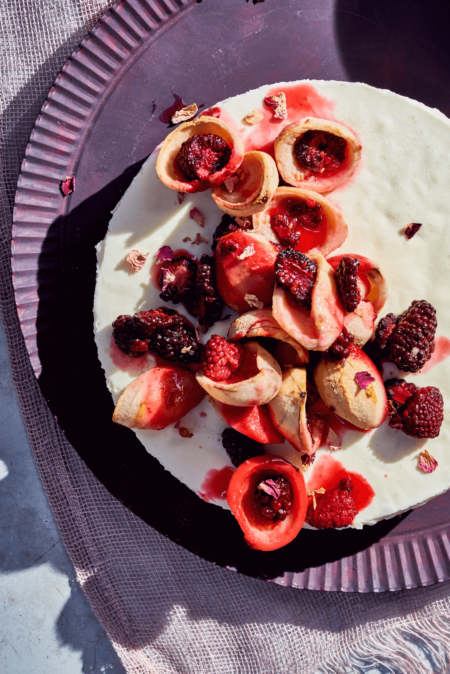
A quite common snack is a slab of guava paste stacked over a slice of white cheese and a spoonful of arequipe—the perfect bite, indeed.
Most airport food stores in Colombia offer tiny, portable versions of this des- sert. Sometimes, you can even find a bite-size white cheese with the arequipe or guava paste already inside, gently oozing out after the first bite. My take on this ubiquitous flavor combination is rather delicate and less sweet.
For the crust:
7 ounces round tea biscuits (200-gram package roll), popularly known as Maria cookies or Maria biscuits, or substitute graham crackers
4 tablespoons unsalted butter, melted
1 teaspoon ground cardamom
For the topping:
1 pound small guavas, peeled, halved, and seeded
3 cups fresh blackberries 2 tablespoons sugar
1 tablespoon water
2 tablespoons sherry
For the filling:
2 (8-ounce) packages of cream cheese, at room temperature
1 cup 2% plain Greek yogurt, chilled
1 cup sweetened condensed milk
1 teaspoon kosher salt
1⁄2 cup arequipe (page 00) or dulce de leche
Preheat the oven to 400°F.
Grease and line a 9-inch springform cake pan with parchment paper. Line a baking sheet with parchment paper.
Make the crust: Place the biscuits in the food processor and grind to form very fine crumbs. Transfer to a bowl and stir in the melted butter and cardamom. Using your hands, press the crust onto the bottom of the prepared pan and use the back of a spoon to even out the dough. Freeze, 20 to 25 minutes.
Make the topping: Place the guava halves and blackberries in a large metal bowl. Sprinkle with the sugar, water, and sherry and toss to coat. Place the guava, cut side down, and the blackberries on the prepared baking sheet and bake in the preheated oven until the fruit begins to brown, burst, and soften, while still holding it’s shape, 20 to 25 minutes.
Make the filling: Place the cream cheese in the bowl of a stand mixer and beat with the paddle attachment until light and airy, 3 to 4 minutes. Pour in the yogurt and sweetened condensed milk and add the salt. Continue mixing to obtain a velvety and airy mixture, about 4 minutes.
Using an offset spatula or butter knife, spread the arequipe evenly over the cookie crust layer that is now fully set. Place half of the guava halves (cut side down) and half of the berries on the arequipe. Reserve the remaining guava and blackberries for serving. Gently pour the cream cheese filling over the roasted fruit, smoothing the top. Transfer to the freezer until set, 1 hour to 1 hour 30 minutes.
Before serving, remove the outer ring of the springform pan, slide the tart onto a pretty cake stand, and garnish with the reserved roasted fruit and their juices. Slice into wedges and serve.
~~~~~~~~~
From the book COLOMBIANA by Mariana Velásquez Villegas. Copyright © 2021 by Mariana Velásquez Villegas. Published by Harper Wave, an imprint of HarperCollins Publishers. Reprinted by permission.
Photos by Gentl & Hyers


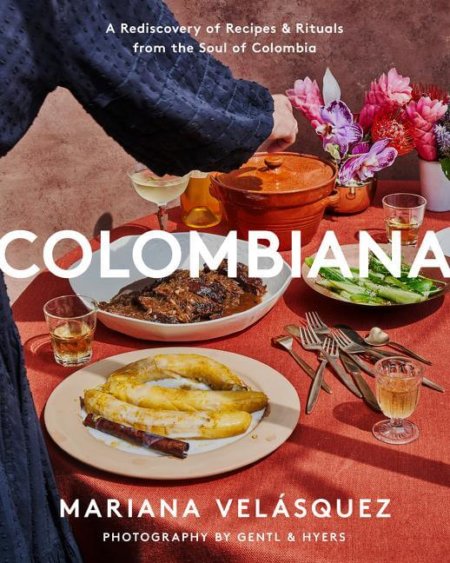


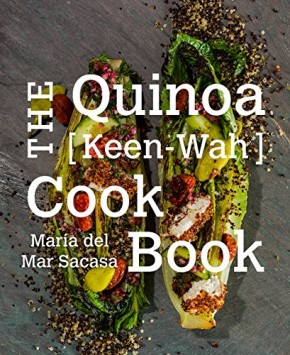
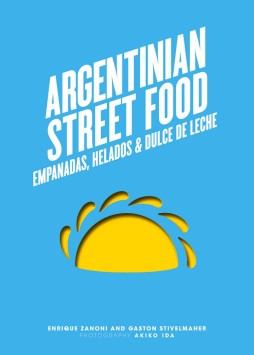
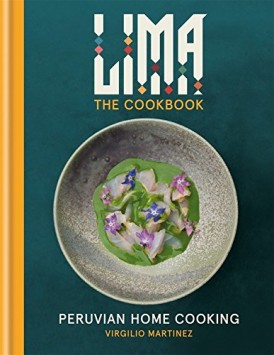
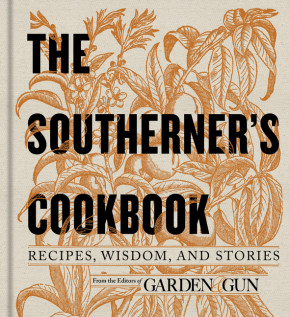
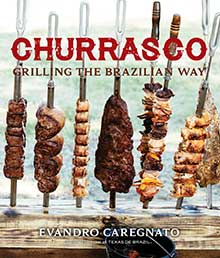
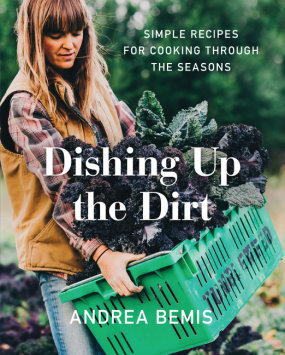
Leave a Reply